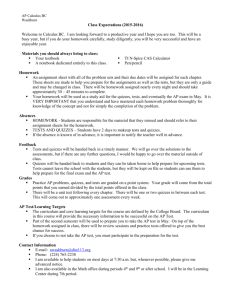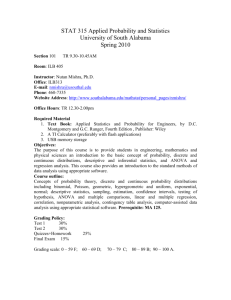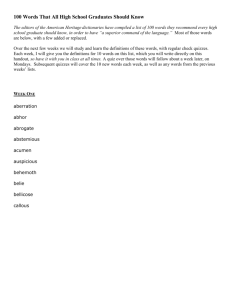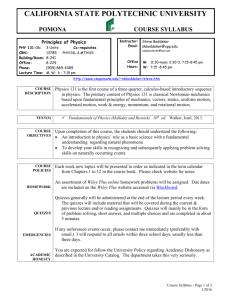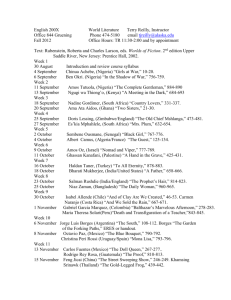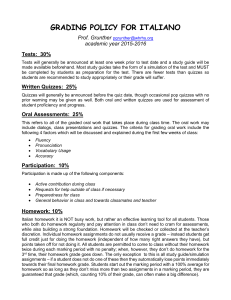Syllabus - Department of Ecology, Evolution, and Natural Resources
advertisement
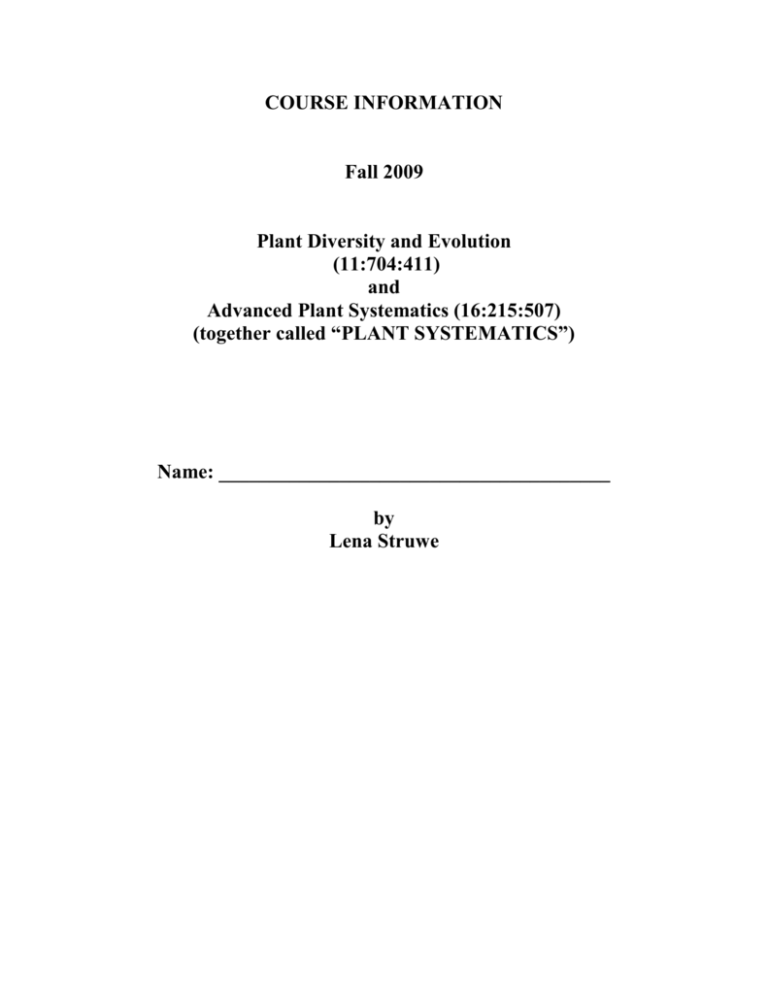
COURSE INFORMATION Fall 2009 Plant Diversity and Evolution (11:704:411) and Advanced Plant Systematics (16:215:507) (together called “PLANT SYSTEMATICS”) Name: _______________________________________ by Lena Struwe Syllabus Plant Diversity and Evolution (11:704:411) and Advanced Plant Systematics (16:215:507) Teacher Dr. Lena Struwe, e-mail: struwe@aesop.rutgers.edu Office: 237 Foran Hall, phone: (732) 932-9711 x235 Office hours by appointment Teaching assistant Sasha Eisenman, e-mail: eisenman@eden.rutgers.edu Course website support: Dr. Priscilla Hockin-Brown, hockin@aesop.rutgers.edu GENERAL INFORMATION Materials for this course will be made available on the internet using the eCompanion software, log on at www.rutgersonline.com Contact Priscila Hockin (hockin@aesop.rutgers.edu) if you have technical problems with the website. The course website will have syllabus, lectures, readings, self-assessment quizzes, links to on-line educational materials (movies, websites, podcasts), and dropboxes for uploading assignments. The course website is divided up in units by chapters in the book, like this: ch 1 intro ch 2 phylogenetics ch 3-5 green land plants ch 6 flowering plants ch 7 monocots and neighbors ch 8 eudicots ch 9 morphology ch 10-12 anatomy ch 13 reproductive biology ch 14 molecular systematics ch 15 plant identification ch 16 nomenclature ch 17-18 collecting and herbaria Please refer to the schedule to find the right lecture, assignment, self-assessment, and other resources. Goals for the class Plant systematics is the study of plant diversity and plant evolution. You will learn: 1. How to discover, describe, and classify plant diversity. 2. The major features and evolutionary origins of vascular plants. 3. The analytical and experimental tools used to understand plant diversity. 4. "Vocabulary" of plant description (see list of terminology) 5. Identification of plants using keys 6. Recognition of important vascular plant families (see list) 7. Distinctive features of land plant diversity 8. The history of land plants through time RESOURCES and MATERIALS Reading The required readings cover all of the course topics and you are expected to read your assignment before each lecture and lab (see Schedule and Reading List). You are not required to read and know the content of the ‘Wildflowers..’ book, this is for reference and keying out plants only. Additional papers may be added later. Reading assignments (excluding the text book) are available on-line. The text book contains many useful references, and you can also use the on-line Subject Guide to Botany and Plant Systematics. Textbooks: Simpson, M. 2005. Plant Systematics. Elsevier Press. (available at Student Co-op). Clemants, S. &. C. Gracie. 2006. Wildflowers in the Field and Forest: A Field Guide to the Northeastern United States (Jeffrey Glassberg Field Guide Series). Oxford University Press. Supplies needed: Hand lens (10X) preferably with neckband so you don’t drop it and loose it 10-30 cm ruler (make sure it is marked in both cm and inches) Plant press and drying material (provided by the Chrysler Herbarium) Old newspapers and cardboard for plant pressing Dissecting kit including: Fine point forceps Dissecting needle/long pin, for dissecting of grasses and other small flowers in field and lab (regular sewing pin with plastic head is fine) Razorblades or scalpel (for cutting plants, some blades provided in lab) Latex gloves (for handling of alcohol-preserved samples, will be provided in lab) Garden shears (good for plant collecting, not necessary) Pencils and erasers for lab reports and drawings LABS and FIELDTRIPS Note about taking lab notes When observing and evaluating plants and their characters drawing is an invaluable tool. Bring a sharp pencil and an eraser to lab. Draw many pictures of plant parts in your notebooks and on your lab worksheet, mark down the names of the parts and plants (Latin genus and family names required), explain in detail the arrangement, texture, color, and shape of each part. Write legible and neat. Lab worksheets that are not readable will not be graded. Grades will be assessed based on both drawings and text (contents and understanding only, not artistic ability - no Picasso or Monet is expected here). Attendance is required for all labs! If you miss a lab due to an emergency, you will have to arrange a make-up session with the teacher and teaching assistant. Some plant material is scarce and hard to get, so there is no guarantee that all material will be available at a later date. Even if you miss a lab you will have to take the lab quiz as scheduled. You can work in teams during the lab if you like and NEVER copy anybody else’s text for the lab assignments. Worksheets, handouts, lab notes, reading assignments. These will be part of the text for the course as well. Reading assignments should be read before each lecture. Lab worksheets should be handed in no later than Monday after the lab and will be returned on Thursdays. Lab and field safety Many plants are poisonous and can cause severe reactions, even death. Be careful not to get anything in your eyes or your mouth. We will also work with alcohol-preserved specimens. Gloves will be provided for this (1 pair per person). Old herbarium specimens can have been treated with arsenic or mercury – wash your hands after working with all material, and please do not eat in the herbarium or in the lab. Dress in suitable clothes for the outdoor field trips – boots/sneakers, long pants and long-sleeved shirts are recommended. WHAT TO KNOW To aid in your study, we are providing a list of families that you should be able to recognize and a worksheet for these, a list of species you should know, and a list of plant terminology words you should know. Graduate students are required to know more plants and terms than undergrads. QUIZZES and GRADING Theory Exams The theory exams (1=midterm and 2=final) will include material from the lectures and the assigned readings (textbook, handouts, and articles). The midterm exam will cover the material through week 1-7. The final exam will cover the remainder of the course, but will also include some material from the first half of the course. Lab (Practical) quizzes The lab exams will include material from the labs and the relevant parts in the textbook and glossary. The two lab quizzes will cover the material seen in the lab plus some ‘unknowns’ and focus on the families you need to know by heart and plant terminology. Included in the lab quizzes will be, among other things, determining plants using keys, descriptions of plants or plant parts, morphological terms, and determination of plant families (see list below). Cheat sheet During lab quizzes and theory exams you are allowed to bring with you 2 pages (one sheet) of handwritten notes on a cheat sheet. However, no computer text is allowed on these sheets, only your own handwriting. You can write small, in different colors, and any text you want, but you are only allowed one sheet for each quiz, giving a total of 3 cheat sheets at the end of class. No other materials and help are allowed during lab quizzes or exams. We will inspect all cheat sheets before the exam starts. Theory Quizzes 1 Lab worksheets Lab Quizzes Species Project Poster Project On-line self-assessments Collection Project Total points 150 (3 quizzes @ 50 points each) 120 (12 worksheets @ 10 points each) 150 (3 quizzes @ 50 points each) 50 (MANDATORY) 50 (MANDATORY) 60 (12 self-assessments @ 4 points each) 100 (10 plants @ 10 points each) MANDATORY 680 total Self-assessments are graded manually so that you get 4 points for each assessment performed, regardless of your performance on the self-assessment. The idea is that you should do the self-assessments (repeatedly if you wish) to improve your learning. If you do the self-assessments you will most likely improve your performance in class significantly and learn a lot more. For projects, points will be taken off for misspellings, wrongly formatted text, sloppiness and similar mistakes, and all plagiarism will be reported to the Dean. If you participate significantly and constructively in classroom discussions and with questions we will strongly consider raising your grade. We will use the gradebook on the course website so you can check your current grade at all times. If not handed in by 5 PM on the due date, the assignment will get an automatic 20% point reduction, if still late after 7 days it will not be graded. The projects are mandatory, and any student that does not hand in all three projects will get a C in the class automatically (or lower, if warranted). If you do not submit a plant collection you will fail the course. Undergraduates will be graded according to undergraduate standards, graduates according to graduate standards on similar assignments. All quizzes are different for undergrads and graduates to reflect different learning requirements. Final grades: A 90-99 % B+ 85-89 % B 80-84 % C+ 75-79 % C 70-74 % D 60-69 % F less than 60% of total grade ACADEMIC CONDUCT Plagiarism All instances of plagiarism or other unacceptable academic conduct will be reported to the Office of Student Conduct and might result in warnings or suspension according to Rutgers rules. Especially, write all hand-in projects by yourself, and never copy from the internet or publications – we are using turnitin.com to check all text handed in by students. Please follow all copyright laws when downloading images from the Internet. Cite all sources for proper acknowledgment (author, year, copyright holder, etc.). PROJECTS There are 3 individual assignments for this course, 2 theoretical and one practical. Please remember to cite all sources for your written presentations and obtain permission if you use copyrighted images (webpage addresses are not enough; name/source and year have to be included). Reference lists have to include all authors and full title of each paper. Projects are independent, i.e., not group projects. Uploading of files: Project 1 and 2 have to be handed in using the drop box on the course website and as a hard-copy printout in Lena Struwe’s mailbox (2nd floor Foran Hall). Projects that are more than one day late will get a reduced grade. Name your files YourName_project1.doc (or YourName_project1.pdf), etc. Sorry, we cannot accept WordPerfect files. You also have to upload your project to the turnitin.com website, see separate instructions. Note on sources of information: Non-refereed, unscientific web sites are not acceptable as sources of information unless for images or maps. You should get all information from books, book chapters, and scientific articles (these can of course be searched for, read on, and downloaded via the web). So, DO NOT CIE WEBSITES, unless they are SCIENTIFIC websites, that lists references and their facts have been checked. All project reports have to include a list of References and follow the correct citation format (see instructions). 1. Species Project: Select a native North American species and have it approved by the teacher. Avoid species that are too common or major crops. Include all of the following in your essay: 1) Latin name for the species, 2) who described it (check on ipni.org), 3) general morphology, 4) which family it belongs to today, 5) image of plant (check copyright!),6) natural distribution (provide a map – see note below), 7) interesting ecology (habitat, pollinator, dispersal, etc.) and 8) References (all sources of data and images must be cited!). Cite at least six references (books or journal articles) as sources for information. Note on distribution maps – if available, use species records at GBIF (gbif.org) and download these and make a distribution map in Google Earth. Detailed instructions will be given out later. If no species records are available, check the USDA’s PLANTS database, or floras for distribution records. The map only needs to cover North America. 2-4 pages (including figures), 12 pt Times Roman, 1.5 line spacing, 1 inch margins. 2. Poster Project Powerpoint poster of one family (undergraduates) or one genus (graduate students). This project will be presented as a poster to the class. It will be handed in to the teacher as a computer file (ppt or pdf) to be printed out and displayed as a poster exhibit in the lobby of Foran Hall. Include the following information: Morphological characteristics, Number of species, Phylogeny and taxonomy, Distribution, Conservation and threats (if any), Ethnobotany (if any known), References, Acknowledgements. Poster size – 3 x 3 feet, do not just too dark background, and include your name on the poster. Free designs, but make it readable. Ideas and advice for postermaking is available on the course website. The poster will be peer-reviewed within the class. The selected plant family and plant genus has to be approved by the instructor of the course before you start. 3. Herbarium Collection 10 non-cultivated species in at least 10 different vascular plant families should be collected, pressed, and labeled. The specimens should be properly documented, pressed, dried, and determined to the correct species before they are handed in. All plants should be fertile (have flowers and/or fruits) and have proper collection labels. See further instructions on separate page. The plant collection assignment is a major part of your grade and worth 100 points, same as the final exam. A perfect collection is possible to achieve, and can easily raise your grade a full letter. So begin early, carefully prepare and identify your plants, and good luck with finding plants. Also, feel free to ask for help during your project from teachers and TA – we are here to help. NOTE: Collections will be returned to students, but you can donate them to the Chrysler Herbarium if you wish. If you do not submit a plant collection you will fail the course. CITATION OF SOURCES OF INFORMATION 1. Cite each figure and table in the text. 2. Include only references cited in text in the Literature Cited section. Please double-check the spellings of authors' names and dates of publication. Check diacritical marks in citations of foreign publications. 3. Use the following standard abbreviations: hr (hours), min (minutes), ft (feet), ft-c (foot-candles), diam. (diameter, when used with a value), km (kilometer), m (meter), cm (cm). 4. Use symbols for percentage (%) and micro (µ). 5. Within parentheses, use a semicolon between types of citations; for example, "(Fig. 4; Table 2)" or "(Jones, 1950; Smith and Doe, 1967, 1968)." 6. Within parentheses, use commas rather than connecting words for a series; for example, "(Smith, 1952, 1959, 1962; Jones, 1962, 1965)." Several references in a series within parentheses should be arranged chronologically (beginning with the earliest date) and then alphabetically for a given year. 7. Do not use parentheses within parentheses. When necessary, use brackets for internal parentheses. 8. Examples of author citations in text a. Two authors: Smith and Jones (1960) or (Smith and Jones, 1960) b. Three authors or more: Doe et al. (1958) For each source you need to know: For each article: Author(s) with initials, year of publication, title, page numbers, journal, volume number. For each book chapter: Author(s) with initials, year of publication, book chapter title, page numbers in book, book title, book editor(s) with initials, publisher, place of publication (city, state). For each book: Editor(s)/author(s) with initials, year of publication, book title, publisher, place of publication (city, state). For internet resources: Author's name (last name, first and any middle initials) [if available, otherwise publisher or organization]. Date of Internet publication (date it was put on the web). Document title. <URL> or other retrieval information. Date of access (when you saw it). For illustrations and images: Copyright holder, source (website, journal article, book, etc.). READ THE COPYRIGHT before use. SAMPLES OF LITERATURE CITED: Journal article Smith, R. P. 1961. Appearance of seed pods. American Journal of Botany 56: 23-25. Book chapter Vernon, P. K. 1966. The evolution of flavonoids in plants. Pages 1056--1095 in T. Swain, ed., Comparative Phytochemistry. Academic Press, New York. Book T. Swain, ed. 1966. Comparative Phytochemistry. Academic Press, New York. LINKS: Citation in Biological Articles: http://www.bedfordstmartins.com/online/cite8.html [the nameyear system is the one you should use – type 2, in the list in this article]

